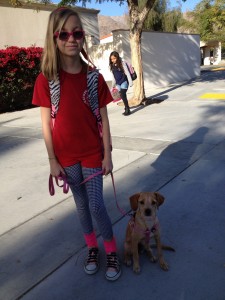Archives for Socialization category
Posted on Aug 20, 2014
Adopt a Shelter Dog, Behavioral Modification, Boxer, Crate Training, Dog Humor, Dog Training, Doggie Rehab, Dogs and Instinct, Socialization, Uncategorized
Teaching one dog a boundary (i.e., waiting at an open door) can be challenging and needs to be taught with minimal distraction as you work up to the major temptations. Teaching it to three dogs….well, the pictures tell the story. “Oscar, Balboa, and Argus, good dogs.” I even tossed out a toy and a ball and the most difficult challenge of all…having their dads walk past them as if greeting a guest at the gate. So smart!


Of course, sit and down are easy in comparison. Don’t tell the senior he isn’t lying down (he gets a free pass for putting up with the new, young adoptee). Such a great family!


Posted on Feb 12, 2014
Adopt a Shelter Dog, Behavioral Modification, Bully Happiness, Dalmation, Dog Humor, Dog Rescue, Dog Training, Doggie Rehab, Dogs and Instinct, Dogs and Sarcasm, Socialization, Teaching Your Dog to Stay, Timid Dog Behavior

Meet Chloe and Coco. Chloe is an adorable, smart, and amazingly mature 8 year old. Her new best friend and rescued pup is Coco. Chloe’s family already had two larger dogs who are very well trained and the addition of this little one was new territory, so I was called. I am more than delighted to have the pleasure of working with this family and their commitment to having a stable, well behaved small dog (not always an easy task with a nervous rescue).
As some of you know, my heart is with assisting timid dogs in gaining confidence and feeling secure in their new homes. Initially, Coco was afraid of – well, as they say, her own shadow. Now? I will let the images do the talking. This is Chloe and Coco after we walked to school (with a lot of distractions) and are waiting for class to start. I am truly amazed and impressed with how bonded these two are and how this little (a-lot-less-nervous-now) pup looks to Chloe for guidance. A reminder that good things come in small packages – and, I’m not just talking about the dog.


Posted on Sep 16, 2010
Dog Psychology, Labradoodle, service dog, Socialization
It is always wonderful to witness a dog that is in service to someone. They walk nicely (and honorably) side-by-side with their human providing some form of service, companionship, and/or support. The jacket they wear is an indication to other humans to not touch or pet the dog as it is working. These dogs are bred and trained for years prior to their being put into service.
I don’t have one of those dogs. I don’t need one either; however, my dog does provide a service. The service is to encourage you to smile. Zoe is always smiling. She is a Labradoodle (plus) mix and is always delighted to be out on a walk. When she walks by someone or even sees them approaching, she begins to smile, sometimes speak, and wiggle her body all to get you to smile. Is she begging? Perhaps. As long as she does it without invading someone’s personal space, I don’t get too concerned.
I have decided that dogs like Zoe should have their own jacket or vest. The inscription on it will read, “Exuberant Dog – Please Pet!” Zoe would also like to add, “oh please, oh please, oh please.” This way, if you see a dog wearing the Zoe vest, you won’t have to wonder if they are friendly. You will also know to brace yourself in the likelihood they will make you smile. So, if you are planning on being in a grumpy mood and you see a dog wearing the “Exuberant Dog” vest, you will know to look the other way. They can be real mood changers. Zoe will knead the floor with her paws in an effort to refrain from jumping, but every once in awhile, she can’t contain her enthusiasm.
Let me know if you’d like to have me interview your dog and make certain they are worthy of donning the “Exuberant Dog” vest!
p.s. The trainer in me has to add that rewarding a dog by giving inappropriate affection when it is overly excited is not good practice and can lead to a dog who is overly anxious and bossy (even if it is for affection). The “Exuberant Dog” vest is purely for comic relief and for those dogs that know if their human asks them to settle down or leave it – they will.
Posted on Jul 15, 2010
Adopt a Shelter Dog, Dog Psychology, Dog Rescue, Learn From A Dog, Rehoming a Dog, Socialization

I can’t take credit for writing the following. Since you are reading my blog, chances are you will find some truth in it. . .
From time to time, people tell me, “Lighten up, it’s just a dog,” or “That’s a lot of money for just a dog.” They don’t understand the distance traveled, the time spent or the costs involved for “just a dog.” Some of my proudest moments have come about with “just a dog.” Many hours have passed and my only company was “just a dog,” but I did not once feel slighted.
If you too think it’s “just a dog,” then you wll probably not understand phrases like “just a friend,” “just a sunrise,” or “just a promise.” “Just a dog” brings into my life the very essence of friendship, trust, and pure unbridled joy. “Just a dog” brings out the compassion and patience that makes me a better person.Some of my saddest moments have been brought about by “just a dog,” and, in those days of darkness, the gentle touch of “just a dog” gave me comfort and reason to overcome the day.
Posted on Jun 17, 2010
Behavioral Modification, Dog Psychology, Socialization
In an article by Jean Donaldson she addresses the question – are dogs pack animals? Studies show they may not be as pack oriented as we typically profess them to be. She concludes with this:
“If we are to support our contention that dogs are pack animals, we will need to account for these many populations where dogs, in the absence of the glue of human confinement and husbandry, simply do their own thing.”
Here’s the complete article: Are Dogs Pack Animals?
Posted on Jun 03, 2010
Barking, Behavioral Modification, Dog Psychology, Socialization
Guess what? Dogs bark. This isn’t the first time you have heard it from me. This post is another segment in why dogs bark. Here’s the scenario:
You are walking down the street with your dog on a leash and working on having your dog heel. Your dog spots another dog in the distance and starts barking (and barking and barking). What is your dog saying?
Your dog’s bark could be saying:
“Look a dog! Hi dog! I’m a dog! Come here dog. We can play!” Or…
“Oh no a dog! A big dog! A little dog! I don’t like how that dog looks or smells. I need to get that dog – now before he gets me (us)!” Or…
“Look a dog! Get me outta’ here! That dog just said he doesn’t like me and to prepare to defend myself. Run!”
There is so much more than just a bark happening in these moments. Some dogs have more obvious triggers than others, and it takes time in learning those triggers and if your dog is being assertive and dominant, passive and frightened, or just wants to have fun.
To those on the other end of the leash, it appears that when our dog sees a dog it goes crazy for no reason and we either panic or get embarrassed. I have a vocal dog, so I have to tell people, “sorry, he’s vocal.” It seems like common courtesy to apologize for our dogs barking. Seldom do humans apologize for being overly vocal. Granted a barking dog can be annoying but for them it is not without purpose.
Observe and learn from your dog, watch their body language, and while you can’t remove their ability to communicate, you can keep them from escalating into panic mode. You can acknowledge what they are saying and they should trust and respect your request for them to be quiet.
Posted on May 20, 2010
Dog Training, Energy and Dogs, Learn From A Dog, Socialization, Timid Dog Behavior
I have clients, particularly those who have a dog with an unknown past, ask if I think their dog has been abused. One of the definitions given for abuse is misuse. I think it applies adequately to the amazing dogs who share our lives.
Misuse doesn’t feel as strong as abuse. If a dog is left alone in a yard without being socialized adequately, I consider that misuse. A dog in this situation may later appear as though someone had hit it because it becomes afraid of everything that wasn’t a part of its life as it matured. It can tuck its tail and cower when it hears an unfamiliar sound as if it had been hit.
A dog may cower and release their bladder when someone reaches for them as if they had been hit in the past, when really it was misused in the sense that it didn’t learn positive touch as a pup. Some of this behavior can be hard-wired, but a lot of it comes from how they are socialized and the appropriate attention given as they mature.
A high energy dog could be considered misused if it isn’t given a job. That job can come in the form of specific training, appropriate exercise, and/or something like agility training which provides focus, exercise, and structure.
Describing our dogs as having been abused should not be something we coddle or shy away from; rather we should find positive ways to encourage these beings to participate and be in life with a family. Most dogs who have been truly abused have forgotten or lost the ability to be dogs. There’s nothing like another confident dog to show them the way. I often bring a dog of mine to work with timid dogs. He does in minutes what could take me hours.
For as much as we love our dogs, we are humans! We need to spend less time attempting to see their humanness and more time seeing who they are as dogs. They will be much happier and so will we. Every dog is different just as every human is different.
If you think your dog has been misused or you may be contributing to a life of misuse, please contact me. I am glad to provide guidance. The more dogs who are happy dogs with happy humans, the fewer that end up in shelters.
Posted on May 09, 2010
Behavioral Modification, Dog Rescue, Doggie Rehab, Socialization, Timid Dog Behavior
I came across the paperwork I had on my precious, little Melody. As I worked with some timid dogs at the local shelter to help them be adoptable, I met a not-so-happy Yorkie who had been surrendered. She had been a breeder at a puppy mill. This is the statement of surrender the woman had to sign in order for this no-kill shelter to take responsibility for her.
STATEMENT OF SURRENDER
I, the undersigned, do hereby unconditionally donate to the Morongo Basin Humane Society, my animal to dispose of as it sees fit, relinquishing all my rights, title and interest in said animal. I further represent that I am the owner thereof, or the agent for the animal. I understand that any animal may be euthanized.
I read and re-read the above paragraph. Knowing Melody as I do now, it’s hard to imagine anyone being able to sign such an agreement. I am in no way faulting the shelter. This is what they have to do and this shelter is great and does so much for so many. I was fortunate enough to bring Melody home to help her trust human touch, and the rest is history.
If you or anyone you know, needs to re-home a dog, please do your best to find a home without surrendering to the already over-crowded shelters. It is traumatic for a dog to go from a loving home environment to a shelter. If I can be of assistance in any way, please let me know.
Posted on May 04, 2010
Behavioral Modification, Dog Commands, Dog Humor, Dog Psychology, Dog Training, Doggie Rehab, Dogs and Cognitive Learning, Socialization
There are so many options when it comes to purchasing a collar for your dog. Should you use a harness? What type of harness is best? If using a collar, is the flat nylon style adequate? Some trainers will only train using a prong/pinch (or power steering collar, as I call them). My personal
favorite is the Martingale-style training collar.
Let’s face it, dog training is dog training when it comes to basic commands. It’s what happens when the leash and collar come off that is the true test. A lot of dogs go into their training mode when a specific collar is used for training versus the one used for a walk. They quickly learn what is expected depending on their “jewelry.” Much like a service or search and rescue dog knows it’s working when wearing a vest. Dogs are smart! We train them well (or they train us well). =)
I make certain that any dog I work with knows their commands regardless of their collar or harness. The collar and leash are tools. The end result is not that your dog responds nicely during the 15 – 20 minutes of training, but rather they listen, respect, and want to please you when training is done. Training becomes a way of life. Aren’t we always teaching others how to treat us!
After the basics, I suggest switching to a 15 – 20 foot leash to perfect “stay.” It’s also beneficial for teaching them to “come” and for distance learning. Too often, after puppy class, the leash and training are set aside until the dog does something not so pleasing to the human. I can assure you, the dog is always great at being a dog and not so great at thinking like a human. It takes (a lot) of time and consistency to create a mutually respectful relationship with your dog.
As a side note, I have seen too many dogs who were broken (for lack of a better word) by harsh training using a prong collar. Not every dog is the same, and it’s important to be willing to try different tools to see what works for your dog. If a trainer/behaviorist only does it one way, I’d find another trainer. No two dogs are the same any more than two humans.
I am happy to answer any questions you have, and if you live in the Palm Springs area, I would love the opportunity to work with you and your fur family.
Posted on Jan 03, 2010
Adopt a Shelter Dog, Behavioral Modification, Dog Humor, Dog Psychology, Dog Training, Dogs and Instinct, Socialization, Uncategorized
I tried and tried to get the dogs to stay awake to help celebrate the coming of the New Year 2010. As their heads bobbed and soft snoring could be heard around the room, I decided to join them. This year, I would celebrate like dogs do.
They go to bed every night and wake up every morning without a care. They sleep when it’s night (and day) and don’t complain when they wake up – whether it’s in the middle of the night or at the dawn of a day. They don’t get anxious or worry that they didn’t do enough last year or what they will do in the coming year.
While it is not exactly how I see my life going this year, it’s a great way to start every day. Every day is a new day and every new day makes a new year. I looked at the dogs and said, “Thanks for that awareness.” They replied, “What the heck are you talking about…where’s our breakfast?” Enough said. HAPPY NEW YEAR!
















